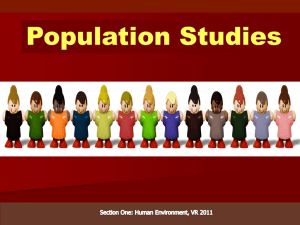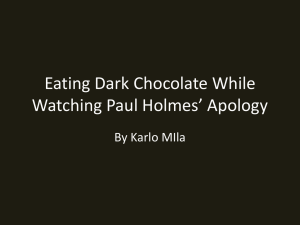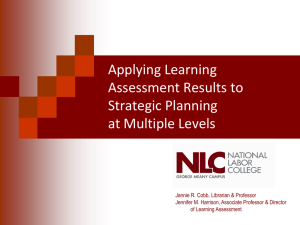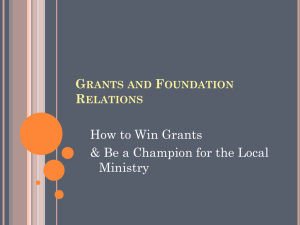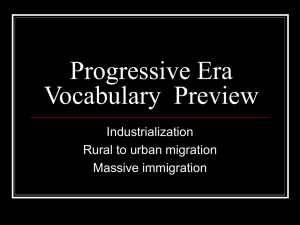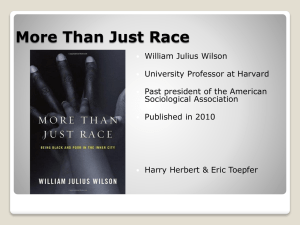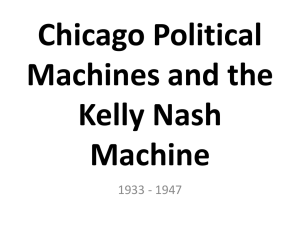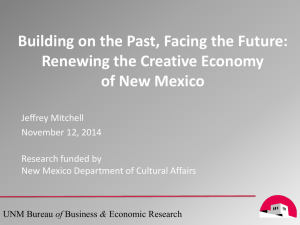Homicide Victims by Race and Gender
advertisement
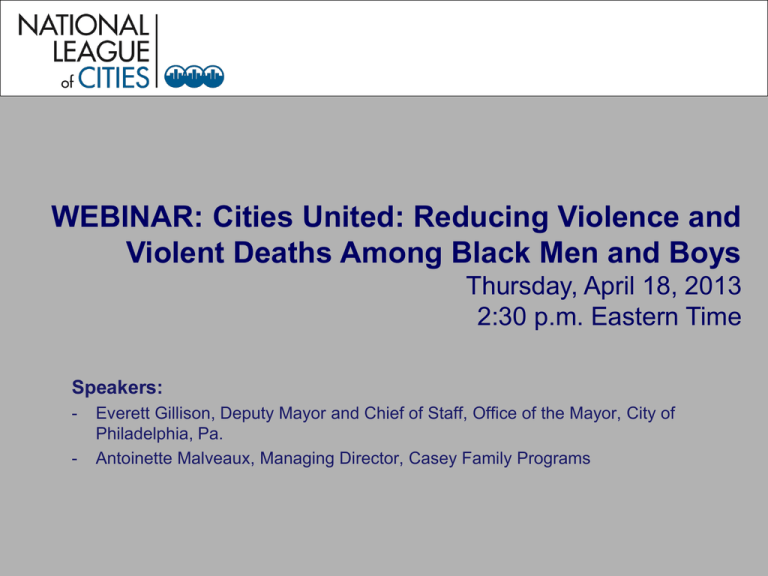
WEBINAR: Cities United: Reducing Violence and Violent Deaths Among Black Men and Boys Thursday, April 18, 2013 2:30 p.m. Eastern Time Speakers: - Everett Gillison, Deputy Mayor and Chief of Staff, Office of the Mayor, City of Philadelphia, Pa. Antoinette Malveaux, Managing Director, Casey Family Programs Homicide Victims by Race and Gender: BALTIMORE 90 80 80.3 70 60 Percent 50 40 30 20 10 5.8 9.8 3.5 0.6 0 White Males White Females Black Males Black Females Other Source: Rhonda Bryant, Center for Law and Social Policy, analysis of data from Bureau of Justice Statistics, United States Department of Justice (2009 Homicide Data) and U.S. Census Bureau www.nlc.org Homicide Victims by Race and Gender: BOSTON 70 60 62.3 50 Percent 40 30 20 18.9 10 9.4 7.5 1.9 Black Females Other 0 White Males White Females Black Males Source: Rhonda Bryant, Center for Law and Social Policy, analysis of data from Bureau of Justice Statistics, United States Department of Justice (2009 Homicide Data) and U.S. Census Bureau www.nlc.org Homicide Victims by Race and Gender: BUFFALO 80 70 67.6 60 Percent 50 40 30 20 10 16.2 10.8 5.4 0 White Males White Females 0.0 Black Males Black Females Other Source: Rhonda Bryant, Center for Law and Social Policy, analysis of data from Bureau of Justice Statistics, United States Department of Justice (2009 Homicide Data) and U.S. Census Bureau www.nlc.org Homicide Victims by Race and Gender: CHICAGO 70 65.0 60 50 Percent 40 30 20 23.9 10 2.8 7.7 0 White Males White Females Black Males Black Females 0.6 Other Source: Rhonda Bryant, Center for Law and Social Policy, analysis of data from Bureau of Justice Statistics, United States Department of Justice (2009 Homicide Data) and U.S. Census Bureau www.nlc.org Homicide Victims by Race and Gender: CLEVELAND 80 70 70.2 60 Percent 50 40 30 20 10 14.0 10.5 3.5 1.8 0 White Males White Females Black Males Black Females Other Source: Rhonda Bryant, Center for Law and Social Policy, analysis of data from Bureau of Justice Statistics, United States Department of Justice (2009 Homicide Data) and U.S. Census Bureau www.nlc.org 70 Homicide Victims by Race and Gender: COLUMBUS 63.6 60 50 Percent 40 30 20 17.8 10 9.3 7.5 1.8 0 White Males White Females Black Males Black Females Other Source: Rhonda Bryant, Center for Law and Social Policy, analysis of data from Bureau of Justice Statistics, United States Department of Justice (2009 Homicide Data) and U.S. Census Bureau www.nlc.org Homicide Victims by Race and Gender: HOUSTON 70 60 58.6 50 Percent 40 30 25.9 20 10 6.9 3.4 0 White Males White Females Black Males Black Females 5.2 Other Source: Rhonda Bryant, Center for Law and Social Policy, analysis of data from Bureau of Justice Statistics, United States Department of Justice (2009 Homicide Data) and U.S. Census Bureau www.nlc.org Homicide Victims by Race and Gender: INDIANAPOLIS 60 50 51.3 Percent 40 30 20 23.9 10 12.8 12.0 0.0 0 White Males White Females Black Males Black Females Other Source: Rhonda Bryant, Center for Law and Social Policy, analysis of data from Bureau of Justice Statistics, United States Department of Justice (2009 Homicide Data) and U.S. Census Bureau www.nlc.org Homicide Victims by Race and Gender: JACKSON, MS 90 80 78.1 70 60 Percent 50 40 30 20 10 7.8 7.8 6.3 0.0 0 White Males White Females Black Males Black Females Other Source: Rhonda Bryant, Center for Law and Social Policy, analysis of data from Bureau of Justice Statistics, United States Department of Justice (2009 Homicide Data) and U.S. Census Bureau www.nlc.org Homicide Victims by Race and Gender: KANSAS CITY 70 60 63.1 50 Percent 40 30 20 23.0 10.7 10 2.5 0.8 0 White Males White Females Black Males Black Females Other Source: Rhonda Bryant, Center for Law and Social Policy, analysis of data from Bureau of Justice Statistics, United States Department of Justice (2009 Homicide Data) and U.S. Census Bureau www.nlc.org Homicide Victims by Race and Gender: LOS ANGELES 60 55.1 50 Percent 40 30 29.1 20 10 6.8 2.5 6.5 Black Females Other 0 White Males White Females Black Males Source: Rhonda Bryant, Center for Law and Social Policy, analysis of data from Bureau of Justice Statistics, United States Department of Justice (2009 Homicide Data) and U.S. Census Bureau www.nlc.org Homicide Victims by Race and Gender: MEMPHIS 80 70 70.9 60 Percent 50 40 30 20 15.2 10 8.9 3.2 White Males White Females 1.9 0 Black Males Black Females Other Source: Rhonda Bryant, Center for Law and Social Policy, analysis of data from Bureau of Justice Statistics, United States Department of Justice (2009 Homicide Data) and U.S. Census Bureau www.nlc.org Homicide Victims by Race and Gender: MINNEAPOLIS 70 65.6 60 50 Percent 40 30 20 15.9 10 9.6 3.2 5.7 0 White Males White Females Black Males Black Females Other Source: Rhonda Bryant, Center for Law and Social Policy, analysis of data from Bureau of Justice Statistics, United States Department of Justice (2009 Homicide Data) and U.S. Census Bureau www.nlc.org Homicide Victims by Race and Gender: NEWARK, NJ 80 75.0 70 60 Percent 50 40 30 20 13.9 10 8.3 2.8 White Males White Females 0.0 0 Black Males Black Females Other Source: Rhonda Bryant, Center for Law and Social Policy, analysis of data from Bureau of Justice Statistics, United States Department of Justice (2009 Homicide Data) and U.S. Census Bureau www.nlc.org Homicide Victims by Race and Gender: OAKLAND 80 70 67.8 60 Percent 50 40 30 20 19.0 10 9.1 1.7 2.5 0 White Males White Females Black Males Black Females Other Source: Rhonda Bryant, Center for Law and Social Policy, analysis of data from Bureau of Justice Statistics, United States Department of Justice (2009 Homicide Data) and U.S. Census Bureau www.nlc.org Homicide Victims by Race and Gender: PHILADELPHIA 80 70 72.4 60 Percent 50 40 30 20 16.5 10 3.2 5.9 2.1 0 White Males White Females Black Males Black Females Other Source: Rhonda Bryant, Center for Law and Social Policy, analysis of data from Bureau of Justice Statistics, United States Department of Justice (2009 Homicide Data) and U.S. Census Bureau www.nlc.org Homicide Victims by Race and Gender: SEATTLE 45 40 35 30 39.3 32.1 Percent 25 20 15 14.3 10 10.7 5 3.6 0 White Males White Females Black Males Black Females Other Source: Rhonda Bryant, Center for Law and Social Policy, analysis of data from Bureau of Justice Statistics, United States Department of Justice (2009 Homicide Data) and U.S. Census Bureau www.nlc.org Homicide Victims by Race and Gender: ST. LOUIS 90 80 70 77.6 Percent 60 50 40 30 20 10 8.6 2.3 White Males White Females 10.9 0.6 0 Black Males Black Females Other Source: Rhonda Bryant, Center for Law and Social Policy, analysis of data from Bureau of Justice Statistics, United States Department of Justice (2009 Homicide Data) and U.S. Census Bureau www.nlc.org False Universalism: Reducing Violent Deaths Among Black Males • Armed with this knowledge, many communities still take a universal approach to violence prevention strategy, programming, and evaluation. • “Universal approaches that are not sensitive to the needs of the particular have uneven impact (Powell, 2011).” – False universalism assumes that targeted policies that address the needs of certain populations become a divisive wedge. – False universalism also assumes that everyone benefits from universal approaches. But universal approaches that are not sensitive to the needs of the particular are never truly universal; they tend to have an uneven impact, and can even exacerbate racial inequality at times. – We need to be universal in our goals but not in our process. www.nlc.org The Cities United Vision • Mayors and other city leaders across the country will form partnerships with other local government officials, community leaders, families, youth, philanthropies, and other stakeholders within their respective cities dedicated to reducing violence and violencerelated deaths among African-American men and boys. www.nlc.org Cities United: Key Partners Principals • City of Philadelphia • City of New Orleans • Open Society Foundations’ Campaign for Black Male Achievement • Casey Family Programs • National League of Cities Core Planning Team • Association of Black Foundation Executives • Grantmakers for Children Youth and Families • John S. and James L. Knight Foundation • U.S. Conference of Mayors • Three appointed youth leaders www.nlc.org Cities United: Participating Mayors • • • • • • • • • • • • Mayor Mayor Mayor Mayor Mayor Mayor Mayor Mayor Mayor Mayor Mayor Mayor Ed Pawlowski - Allentown, PA Thomas M. Menino - Boston, MA Joseph P. Riley, Jr. - Charleston, SC Anthony Foxx - Charlotte, NC Rahm Emanuel - Chicago, IL Frank Jackson - Cleveland, OH Michael Coleman - Columbus, OH Michael Hancock - Denver, CO William Bell - Durham, NC Harvey Johnson - Jackson, MS Greg Fischer - Louisville, KY Paul Soglin - Madison, WI • • • • • • • • • • Mayor Mitch Landrieu - New Orleans, LA Mayor Setti Warren - Newton, MA Mayor Leon Rockingham, Jr. - North Chicago, IL Mayor Andre Pierre - North Miami, FL Mayor Michael Nutter - Philadelphia, PA Mayor Brenda Lawrence - Southfield, MI Mayor Marilyn Strickland - Tacoma, WA Mayor Bob Buckhorn – Tampa, FL Mayor Shelley Walsh - University City, MO Mayor Vincent Gray - Washington, DC www.nlc.org BMA Municipal Action Guide BMA Guide: 1. The Challenge 2. Strategies 3. Action Steps 4. Resources Action Steps: • Strengthening families • Improving educational achievement • Expanding access to familysupporting jobs • Reducing violence and violencerelated deaths www.nlc.org NLC’s Institute for Youth, Education, and Families • City Leadership to Promote Black Male Achievement: – www.nlc.org/iyef – Request additional print copies by emailing black@nlc.org • Contacts: – Leon T. Andrews, Jr., (202) 626-3039 or andrews@nlc.org – Jerrilyn Black, (202) 626-3128 or black@nlc.org www.nlc.org Cities United: Webinar April 18, 2013 Antoinette M. Malveaux Managing Director of Strategic Engagements and Initiatives Why Cities United? Many foundations focus their investments on improving the well-being of communities, and care about ensuring a socially just environment for their residents. 27 Why Cities United? Because of the epidemic of violence in some cities, certain interventions are needed to break the cycle of violence, and provide positive alternatives and pathways for the communities and residents where specific foundations fund. 28 The role of Foundations Foundations hold a valuable position in the fabric of communities. They can: • Help raise awareness and sustain the focus on an issue • Convene disparate organizations and leaders– politicians, policy makers, advocates, community organizations, faith institutions, etc.– to focus collectively and continually on an issue 29 The role of Foundations Foundations can: • Bring experts into a conversation to help frame the thinking around appropriate interventions, which includes bringing research, data, and content • Invest in programs that are innovative or show promising practices; help conduct evaluations to become evidence-based; spread evidencebased programs to other communities 30 The role of Foundations Foundations can: • Target their dollars on effected-groups in a way government may not be able to • Be an effective partner and catalyst for partnership within communities 31 On Violence This issue is gaining national attention for many reasons: • Data • Devastating impact on communities and neighborhoods • Devastating impact on families and children • Prevalence of guns – illegal guns that are used in violent crimes in communities • Flashpoint incidences that catalyze action (i.e. Sandy Hook) 32 On Violence There is a lack of opportunities and positive pathways for many low-income and marginalized youth and families, especially those of color. Opportunities include: • Access to quality education • Access to living wage and legal employment • Policies that prevent denying access to employment, housing, and basic rights for those re-entering society 33 Foundations focused on Black Males Foundations focused on Black Males in education achievement, include: • Open Society Foundations: Campaign for Black Male Achievement • Robert Wood Johnson Foundation: Gathering of Leaders • The California Endowment: Building Healthy Communities, (3 of 14 communities in California on life outcomes for Black Men) • The Heinz Endowment: African American Men and Boys Initiative • The Knight Foundation: What it Takes; and “Boy Don’t Turn your Back: The Power of Resilience) 34 Foundations focused on Black Males Foundations focused on Black Males in education achievement, include: • Mitchell Kapor Foundation: Black Boys College Bound Initiative • Schott Foundation for Public Education: The Black Male Donor Collaborative • Winthrop Rockefeller Foundation: Black Male Retention in College • Association of Black Foundation Executives: Black Men & Boys Initiative • Grantmakers for Children Youth and Families: Healthy Men, Healthy Communities 35 Foundations focused on Black Males Other emerging collaborative efforts: • The Joyce Foundation • Boys and Men of Color Foundation Leaders Pledge to Action • Cities United • California Community Foundation – BLOOM 36 How Foundations Engage with Cities United • Foundations, regardless of the scope of grantmaking (local, state, regional, or national) can participate as partners • Foundations that don’t have an explicit portfolio focused on men and boys of color, or black males, can participate as partners 37 How Foundations Engage with Cities United Locally, Foundations can engage by: • Working with Mayors in the cities that join Cities United • If your city, or a city you fund, is not involved, engage with the Mayor and help influence him or her to participate in Cities United 38 How Foundations can support Cities United Locally, Foundations can engage by: • Providing support based off of results from the Cities United assessment • Help provide access to thought leaders and opportunities to share “best thinking” in order to develop a comprehensive strategy 39 How Foundations can support Cities United • Expert consultation: consider engaging grantees and staff to work with Cities United city leaders to address specific challenges faced by Black men and boys • Leverage your convening power: bring organizations together and support the collaboration process between groups. When Foundations call, typically organizations (i.e. community-based, city, business, and other public sector representatives), will come 40 How Foundations can support Cities United • Give advice on how to partner and collaborate: encourage existing grantees to work together to meet the needs of black men and boys 41 How National Funders can support Cities United • Fund complementary strategies. For example: fund youth engagement and youth leadership strategies that focus on or are intentional in including Black youth • Engage Mayors in cities where your grantmaking is focused; encourage Mayors to participate in Cities United 42 How National Funders can support Cities United • Support implementing Cities United nationally. Resources are needed to fund TA efforts, communications, national convenings, national experts, project management 43 How National Funders can support Cities United • Provide experts from your consulting and grantee network to provide TA to Cities United cities • Provide general support for Cities United 44 Finding Funding for Black Men and Boys Efforts • See previously mentioned organizations • BMAfunders.org – a resource within foundation center, funded by Open Society Foundation – provides access to Interactive mapping tool with funding data Timeline of philanthropic milestones in the field Tools and resources for assessing project outcomes Research reports and case studies Video and multi-media content 45 Cities United: Our Young Men Can’t Wait Presented by the City of Philadelphia Steps cities can take now to stop the violence. The Philadelphia Landscape The total number of murders committed in 2012 was 331 In 2011, there were 316 murders in Philadelphia. 75% of those murder victims were black males. 80% of those homicides were committed by black males. Build Political Will to Change Mayor Nutter through his national profile has engaged mayors across the country on not only the issue of the deaths of Black men and boys, but also: Is a chief advocate for Mayors Against Illegal Guns Developed The Sandy Hook Principals Worked with Pennsylvania Attorney General Kathleen Kane to close the Florida loophole Create grids across the city to identify the neighborhoods most in need. The PhillyRising Collaborative is the City of Philadelphia’s new way of doing business. PhillyRising targets neighborhoods throughout Philadelphia that are plagued by chronic crime and quality of life concerns, and establishes partnerships with community members to address these issues. The primary objective is to: Fight crime and the fear of crime; including terrorism Build sustainable, responsive solutions to the concerns of people living and working in each neighborhood Develop cost-effective methods for improving service delivery to each neighborhood; Help those living and working in the PhillyRising neighborhoods to realize their vision for their community. Create a City-wide Commission Originally established in 1991 by then Mayor W. Wilson Goode the Mayor’s Commission on African-American Males is tasked to address the issues related to unemployment, incarceration, lack of education and health within the community. Re-instituted in September 2011 by Mayor Michael Nutter, the commission will seek solutions to the issues facing the community, as well as establish policy recommendations for opportunities and programs specific to African American Males. Workforce Readiness Through the Philadelphia Streets Department the City of Philadelphia launched a new program in January called “Philly Future Track,” which provides job-skills training and real-world work experience to 130 young adults in Philadelphia. Using service as a strategy to build civic and environmental stewardship, Philly Future Track will provide individuals with a paid position involving community service and other life and career building skills during a six-month period. The participants were not previously enrolled in higher education and were unemployed. For three days a week over the course of six months, participants will work in teams on neighborhood beautification projects with direction from the Streets Department. The remaining two days are spent in the classroom, where participants will learn job readiness skills. Stop the Cycle of Violence The Office of Juvenile Justice & Delinquency Prevention awarded our City the Community Based Violence Prevention Demonstration Program Grant. The Program grant provides $1.5 million, over three years, to cities to replicate successful models and programs. The City of Philadelphia and its partners will use this grant to reduce shootings and homicides by partnering with Temple University to help expand the Philadelphia CeaseFire program. The grant is targeted where the need is greatest: within neighborhoods plagued with shootings and homicides, with the goal of reducing violence among 14-24 year olds in those neighborhoods. Both lift up the belief that violence is a public health issue, because hurt people hurt people. Be systematic about targeting resources where they are most needed In January of 2012, Philadelphia launched GunStat, a collaborative, multi-agency effort to reduce gun violence by data-based tracking of gun violence focused on targeted, high-violence areas. GunStat is an enhancement to the crime analysis work the Philadelphia Police Department is already using and is designed after their Crime Briefings Strategy from 2008. It focuses on identifying violent offenders, gun crimes, arrests, and results through the court system, and facilitates better tracking of persons on probation or parole. Criminal justice, law enforcement, federal, and community partners, including the Prison system and Probation and Parole, assist in the GunStat program. Connect city leaders in a national network In September, the City of Philadelphia was accepted through a competitive process as an expansion site for the National Forum on Youth Violence Prevention by OJJDP. Led by the Mayor’s Office and the Office of Public Safety and the Violence Prevention Collaborative, the City’s Forum will bring together city department and agencies, community nonprofits, District Attorney’s Office, academics, and community members to create a multi-year strategic plan for the city to reduce the number of shootings and homicides amount youth and young adults ages 14 to 24 in the target “hotspots.” All members involved in the process will work together to create an integrated plan around improved prevention, intervention, enforcement, and reentry practices. “For to be free is not merely to cast off one's chains, but to live in a way that respects and enhances the freedom of others.” - Nelson Mandela Connect with the YEF Institute Web: www.nlc.org/iyef E-newsletter & Peer Networks: http://my.nlc.org/eweb Blog: http://citiesspeak.org Twitter: Facebook: www.twitter.com/yefinstitute www.facebook.com/yefinstitute www.nlc.org Thank You For Attending Today’s Webinar If you or your mayor is interested in learning more, please contact Jerrilyn Black at (202) 626-3128 or at black@nlc.org
